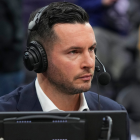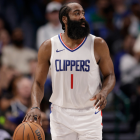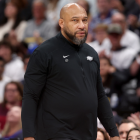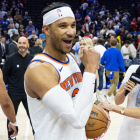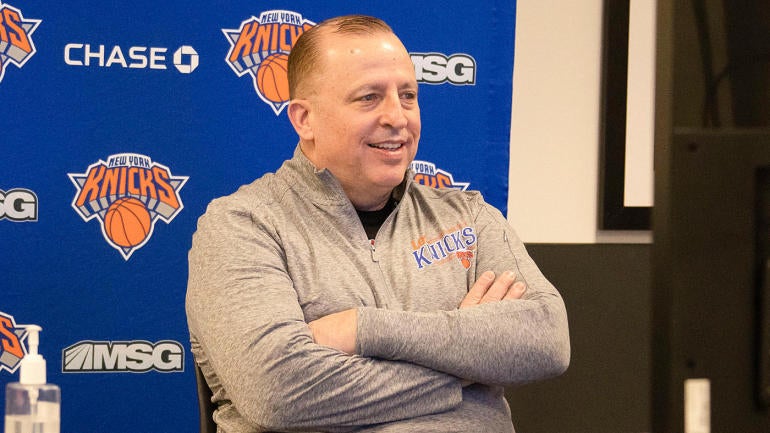
Two teams are still playing in the NBA Finals. The remaining 28? They're gearing up for an offseason that is quickly approaching. The 2021 NBA Draft is only 10 days away. Free agency begins in two weeks. Trades will start pouring in well before that. Get ready for the NBA's annual summer pandemonium.
But as always, certain teams are far better situated for it than others. Most of the teams we've seen deep into the postseason may be capped out, but the teams hoping to unseat them in the near future are not. So with the spending spree coming up, let's look at where all 30 teams stand in relation to the cap. Who has space? Who has which exceptions? Who's going to be active this summer, and who's going to sit things out? Before we figure that out, here are a couple of quick notes:
- For this exercise, we will be using a projected cap of $112,414,200. That is a three percent increase of last year's $109,140,000 cap, the minimum bump agreed to between the players and the league in the wake of last season's coronavirus-induced stoppage. The league will audit itself in the early days of the offseason and could perhaps come up with a higher number, but in all likelihood, teams will be working with that $112.4 million figure. The luxury tax projection is roughly $136.6 million.
- All teams have access to one version of the mid-level exception. Teams with cap space have the smallest version, which started at $4.7 million last offseason and can last up to two years. Luxury tax teams are in the middle. Their mid-level exception started at $5.7 million and could last up to three years. Finally, teams that are above the cap but are willing to stay beneath the apron (a figure roughly $6 million above the tax line) have access to the non-taxpayer mid-level exception. Last offseason, that exception started at around $9.3 million and could last up to four years. Expect all three figures to increase slightly this offseason.
- We will be viewing team salaries as they stand right now. Most teams could theoretically create space if they traded enough players. Most teams have cheap, non-guaranteed contracts at the end of their bench. Unless otherwise specified, we will assume for now that teams want to keep those players.
So, with that in mind, let's dive in. Here is an approximation of how much spending power each team will have this offseason.
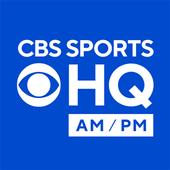
CBS Sports HQ Newsletter
Your Ultimate Guide to Every Day in Sports
We bring sports news that matters to your inbox, to help you stay informed and get a winning edge.
Thanks for signing up!
Keep an eye on your inbox.
Sorry!
There was an error processing your subscription.
Will definitely have max cap space
New York Knicks: The cap space kings of the 2021 offseason can create as much flexibility as they need. If they renounce all of their own free agents, they can get up to around $50 million in space. Don't be surprised if that amount winds up being a bit lower, though. The Knicks had a couple of bargain contracts last season that will have relatively low cap holds this offseason. Derrick Rose, for instance, has a cap hold of only around $10 million. Nerlens Noel is even lower at $6 million, and Reggie Bullock is the cheapest of the three at $5.5 million. All three are players the Knicks would theoretically like to retain. If that is indeed the plan, the Knicks could keep all three on their books, spend the remaining $29 million or so they'd have in space and then bring all three back on new deals. This might be difficult for Noel, whose non-Bird rights allow the Knicks to offer him only $6 million without dipping into cap space, but they have so much room to operate that doing so might not be a problem. New York can do essentially whatever it wants this offseason.
San Antonio Spurs: The Knicks have the most potential space of 2021, but San Antonio has the most practical cap room. Even if the Spurs want to retain their veteran free agents, cap holds on DeMar DeRozan, Rudy Gay and Patty Mills are so enormous that the only reason to operate above the cap would be if the Spurs planned to bring back all three. Realistically, they won't do so, and will therefore renounce their free agents and re-sign any they want to retain with space. They'll have plenty of it. With 10 players already signed and a lottery pick incoming, the Spurs are set to have around $48 million in space this offseason.
Oklahoma City Thunder: The Thunder might have topped this list before acquiring Kemba Walker, but Oklahoma City is strategically using its space to acquire assets. It got the No. 16 overall pick from Boston to take on Walker, and will almost certainly use more of its space to solve other teams' financial woes. Fortunately, the Thunder will have plenty of space to do that with. Even accounting for their three first-round picks, the Thunder will hover around $38 million in space before making any more moves.
Will probably have significant space, but not quite the max
Dallas Mavericks: There are two major stories for the Mavericks. First, there's Josh Richardson's $11.6 million option. If he declines it, Dallas starts the offseason with over $32 million in space. If he picks it up? The Mavericks fall closer to $21 million, though they can shave a bit more by declining the team option of Willie Cauley-Stein. At that point, Dallas needs to decide what it plans to do about Tim Hardaway Jr. and his $28.5 million cap hold. In all likelihood, Hardaway's next deal will be smaller than that, so even if they want to keep him, it would make more sense to renounce him and just sign him to a new deal. If, for whatever reason, they view retaining any other players as a priority, they could simply operate above the cap and keep Hardaway, Boban Marjanovic and perhaps even JJ Redick (as unlikely as that appears). Regardless of what Richardson does, though, Dallas will probably try to use cap space this offseason.
Miami Heat: Miami's situation is complicated for a variety of reasons. There is an argument against creating cap space at all for the Heat. Doing so would cost them Goran Dragic, Andre Iguodala, and unless he's willing to take a massive pay cut, Victor Oladipo. If Miami thinks its next major addition will come through trade, picking up its options on Dragic and Iguodala would give the team a ton of valuable expiring salary, but if the Heat want to make such an addition in free agency, they'll have to hope they can do so without true max space. The extension they signed Bam Adebayo to last offseason combined with the dead money they incurred by stretching Ryan Anderson in 2019 made that impossible. At most, they can create around $27 million in room, and even that requires a pretty bold gambit. Right now, restricted free agents Duncan Robinson and Kendrick Nunn have $4.7 million cap holds. Miami can lower those holds to $1.7 million by pulling its qualifying offers and making them unrestricted free agents, a trick that only works because of how underpaid Robinson and Nunn have been over the past few years as undrafted free agents. The danger in doing so would be some other team swooping in and out-bidding Miami. They don't have to pull their qualifying offers immediately, though, so the Heat could verbally agree to new contracts with them before taking such risks. Then, they would wait to actually sign both until after they've used their space on other players, thus maximizing those low cap holds.
Toronto Raptors: Toronto's situation is similar to Miami's in many ways. If the Raptors want to keep Kyle Lowry, their best bet would be to operate above the cap and keep the salaries of Chris Boucher and Aron Baynes on the books (with Baynes likely serving as trade fodder). They can't quite get to the max in part because of the extension they signed OG Anunoby to last offseason, but they can still get to around $27 million if they use the same trick Miami might with Robinson and Nunn on their own restricted free agent, Gary Trent Jr. They'll likely do just that, but considering Boucher's value, expect the Raptors to retain him and clock in at around $21 million in space this offseason unless a truly special opportunity arises.
Charlotte Hornets: The Hornets are our third consecutive team with access to the "pull the qualifying offer" trick in the name of maximizing space. Their restricted free agent is Devonte' Graham, who will almost certainly be back. The same cannot be said for Malik Monk, who is also restricted, but has a $16 million cap hold that simply isn't worth retaining. If they want him back, their best bet is either signing him with space or hoping he'll take the cap room mid-level exception. Assuming they renounce Monk and make Graham unrestricted, they're looking at almost $25 million in space to pursue a new center. That figure should be substantially higher, but remember, the Hornets curiously chose to use the stretch provision on Nicolas Batum last offseason to create the space needed to sign Gordon Hayward. Had they found that space through trade, they'd have an extra $9 million to use this offseason.
Memphis Grizzlies: Memphis has only one significant financial decision to make before free agency: Is it keeping Justise Winslow? His $13 million team option is the difference between $24 million in cap space and $11 million, but even if the Grizzlies decline that option, there's no guarantee that they spend their money this summer. Even if they extend Jaren Jackson Jr. this offseason, the expiring contracts of Jonas Valanciunas, Kyle Anderson and Tyus Jones could give the Grizzlies significantly more cap space in 2022 as long as they don't make any major commitments this offseason. The 2022 class is not only stronger at the top than 2021, but has far more of the two-way wings the Grizzlies will likely seek out with their eventual space, so don't be surprised if Memphis sits out the frenzy this year so it can evaluate the players it currently has under contract before reconstructing the roster a year from now.
Could create meaningful space with sacrifices
Phoenix Suns: Yes, you're reading this correctly. The Western Conference champion Phoenix Suns can technically get to around $28 million in space … but only if Chris Paul leaves. All signs suggest that he plans to stay, though, which creates some other questions. If Paul opts into the final year and $44.2 million on his deal, the Suns would have only around $10 million in room beneath the tax line before re-signing any of their own free agents. If he re-signs on a long-term deal, he might do so at a lower annual salary. That would give the Suns more room to potentially bring back key reserves like Cameron Payne and Torrey Craig or even use the non-taxpayer mid-level exception on an outsider. Don't expect the Suns to make many other long-term commitments this offseason, though. Deandre Ayton and Mikal Bridges are both extension-eligible, so those deals will kick in for the 2022-23 season and make the Suns one of the NBA's most expensive rosters. Their goal this offseason will be to keep as many players as possible without going above the tax line. They're going to be in tax territory for several years down the line, so delaying the repeater clock is critical.
Atlanta Hawks: Atlanta and Phoenix are in the same boat. The Hawks can get to around $16 million in space, but only if they lose John Collins. They likely don't want to do so, but just as Phoenix has to re-sign Bridges and Ayton, the Hawks know that Trae Young and Kevin Huerter are also extension-eligible this offseason. De'Andre Hunter and Cam Reddish are only a year behind, and eventually, the Hawks are going to have to decide which players they can afford to keep and who is going to get sacrificed for financial purposes. Assuming Collins is re-signed, though, Atlanta should still have enough room beneath the tax line to either keep Lou Williams and/or Tony Snell or perhaps use the non-taxpayer mid-level exception on a short-term addition.
Chicago Bulls: The Bulls are stuck between a rock and a hard place. Yes, they have the ability to create cap space, but they might have to use it to renegotiate and extend the contract of Zach LaVine, who is making well below his max right now. If they don't, they risk losing LaVine for nothing in free agency next year. But if they do? They lose the flexibility to put a winning team around him. Let's say Chicago rolls the dice and doesn't extend LaVine this offseason. With the contracts currently on their books, the Bulls are looking at roughly $11 million in space. However, Thaddeus Young ($6 million out of $14.2 million) and Tomas Satoransky ($5 million out of $10 million) both have partially guaranteed deals. Ryan Arcidiacono is fully non-guaranteed at $3 million. Waiving all three would immediately create an extra $13 million or so in space once incomplete roster charges are factored in, and those savings would be even greater if the Bulls chose to stretch them over multiple years. Speaking of the stretch provision, the Bulls could also use it on Al-Farouq Aminu to create another $7 million or so in room. Ultimately, the Bulls are likely to either waive or waive-and-stretch several of these players, but not all of them. Who they choose to dump will determine how much space they have to find a point guard. If they're aggressive enough, perhaps they can even create the $14 million or so they'd need to extend LaVine at his max in addition to making such a move, though that would appear unlikely.
Cleveland Cavaliers: If Cleveland left its roster alone right now, it would have roughly $18 million in space. However, that wouldn't account for the No. 3 overall pick or restricted free agent Jarrett Allen. Together, they push Cleveland toward the non-taxpayer mid-level group. However, if the No. 3 overall pick is used on Evan Mobley, the Cavs' long-term center position is suddenly occupied. That might make them more amenable to a sign-and-trade involving Allen. If he's gone, Cleveland suddenly has roughly $10 million in room to work with. The Cavs could then start to carve out some extra room by releasing the four non-guaranteed players at the bottom of their roster, but the other big-ticket question involves Kevin Love. Might he and the Cavaliers consider a buyout? Depending on the amount he agrees to surrender and whether or not they stretch the remainder, buying out Love could create an enormous amount of space for Cleveland. At this stage, that appears unlikely. For now, expect Cleveland to keep Allen and eschew cap space.
Detroit Pistons: The Pistons are roughly $10 million below the cap at this moment, but the No. 1 pick wipes away that space. Detroit could create more of it by waiving Rodney McGruder, whose $5 million salary is non-guaranteed, and Cory Joseph, whose deal only guarantees him $2.4 million. They'd probably like to keep the tiny $2.1 million cap hold of restricted free agent Hamidou Diallo on the books after a strong season, but the Pistons have no other free agents they desperately need to keep (though Saben Lee has earned a minimum deal at the very least). All in all, these simple steps can get the Pistons to around $11 million in space if they want it.
New Orleans Pelicans: The Pelicans would have around $13 million in space if they let go of their own free agents. They likely won't do that, though, because it would mean renouncing Lonzo Ball and Josh Hart. At the very least, both could net assets back in a sign-and-trade. More likely, the Pelicans try to bring them back. It just isn't worth the assets it would take to move one of their bad contracts (Steven Adams, Eric Bledsoe) and make a run at max cap space considering the relatively weak class that is about to enter free agency.
Non-taxpayer mid-level crowd
Orlando Magic: The Magic are below the cap at this moment, but almost all of their space is going to get wiped out by the NBA Draft. Orlando has two top-10 picks at No. 5 and No. 8 overall. Those two will cost them over $11 million, so barring a surprise move, cap space is likely out of the question. That should suit the Magic just fine. They are rebuilding, so there's no guarantee they even bother to use the mid-level exception.
Sacramento Kings: When you factor in the No. 9 overall pick, the Kings are only around $4 million below the cap. That's a problem for Sacramento because free-agent center Richaun Holmes only has Early Bird rights. They can only pay him 105 percent of the non-taxpayer mid-level exception without creating the cap space to go higher. If they want to make a competitive bid, they are going to have to trade at least one of their more expensive veterans. Otherwise? They're using their mid-level exception to pursue a replacement.
Indiana Pacers: It's a bit unfair to put Indiana in this group. The Pacers could use the non-taxpayer mid-level exception, but realistically probably won't. They are roughly $12 million below the tax line right now, but that does not include free agents Doug McDermott and T.J. McConnell. Indiana's ownership is stingy in the best of times. It probably isn't paying the tax in the middle of a pandemic for a team that didn't make it past the play-in stage this season. Barring a trade, they'll likely be able to afford one of McDermott, McConnell and the mid-level exception. If they're able to get off a bigger contract like Jeremy Lamb's, they could perhaps go for two, but all three is almost certainly out of the question.
Denver Nuggets: Denver is hovering right around the cap after Will Barton reportedly opted out. JaMychal Green has a player option as well, and without him, the Nuggets would actually dip far enough below the cap to conceivably use space if they wanted to (which, given their internal free agents, they probably wouldn't). More realistically, they are accounting for Green's return through either his option or a new deal, and that puts all eyes on Barton. The Nuggets would probably prefer to re-sign him for multiple years at a salary close to his last deal (in the $13-15 million range), but if he leaves, they can try to replace him with the non-taxpayer mid-level exception. Paul Millsap will probably be retained with Bird rights, but expect the Nuggets to be stingy on long-term deals this offseason. Michael Porter Jr. is extension-eligible and Aaron Gordon's deal expires after next season. Throw in the supermax extension Nikola Jokic will likely receive next offseason and the Nuggets are about to get very, very expensive. With that in mind, paying the tax this season is probably out of the question. Denver needs to delay the repeater clock as long as possible because it's going to be paying the tax for years to come.
Houston Rockets: Houston is around $14 million below the cap at this moment, but its three first-round picks are going to cost roughly $11.5 million. That makes cap space somewhat unrealistic. Maybe the Rockets re-sign Kelly Olynyk. Maybe they use the mid-level exception. Otherwise? Expect a fairly quiet free agency period.
Trying to avoid the tax
Washington Wizards: The Wizards are roughly $11 million below the projected tax line, but most of their roster from last season is intact. They have a few younger free agents they'd like to retain fairly cheaply (Garrison Mathews, Isaac Bonga), but ultimately, the decision will be whether they want to use their remaining space beneath the line to retain Robin Lopez or pursue someone else with part of the mid-level exception. The Wizards could choose to do both and pay the tax as a show of good faith to 2022 free agent Bradley Beal, but with a non-contending roster, that seems like a longshot.
Minnesota Timberwolves: Minnesota has one of the simplest cap sheets in basketball. They are roughly $5 million below the tax right now. The biggest expenditure the Wolves are likely to make before any trades would be signing last year's No. 23 overall pick, Leandro Bolmaro, to a rookie-scale deal. After that? They'll likely keep things cheap to stay below the tax line. If there's a big move here, it's probably coming on the trade market.
Boston Celtics: The Celtics took an important financial step when they turned Walker into Al Horford. That trade got them below the tax line, but staying below it won't be easy. They have only around $8 million in room beneath the tax to potentially re-sign Evan Fournier, who made more than twice that much last season. He is their only major internal free agent, but Boston may have to attach a pick to move Tristan Thompson just to be able to afford him below the tax. If the Celtics were to lose Fournier, they could use the non-taxpayer mid-level exception to try to replace him, but lingering over all of this is the potential for Boston to generate meaningful cap space next offseason. The Celtics have only two fully guaranteed contracts for the 2022-23 season: Jayson Tatum and Jaylen Brown. Horford is partially guaranteed for $14.5 million, a tradable figure with the right picks attached, and all of their other leftover players have team options on their rookie deals. Will the Celtics prioritize this season, or saving flexibility for 2022?
Probably paying the tax
Portland Trail Blazers: Portland has around $21 million below the tax line, but that accounts for only eight players. Norman Powell isn't one of them, and the Blazers wouldn't have traded for him if they weren't comfortable with the idea of paying him. Throw in the almost non-existent bench and the Blazers are going to have to pay the tax to field a competitive team. A Damian Lillard trade could change the equation, but for now, it would be hard to imagine Portland keeping Powell and staying below the line without a trade.
Los Angeles Lakers: If Montrezl Harrell opts in, the Lakers will have around $12 million beneath the tax line with only eight players accounted for (including the No. 22 overall pick). That does not include free agents Dennis Schroder, Alex Caruso, Talen Horton-Tucker or Andre Drummond. Some combination of those players will be back. There are only two feasible paths for the Lakers to avoid the tax: allow their free agents to walk for nothing, or some sort of unforeseen gambit to trade veterans that are already in place to create cap space. Neither scenario is going to happen. The Lakers are paying the tax.
Philadelphia 76ers: Philly has around $5 million in space beneath the tax line, but George Hill is only guaranteed around $1.3 million. Waiving him would create some breathing room if the 76ers want it, but they'd likely prefer to keep him as salary fodder for a possible trade. Ideally, they would re-sign Danny Green using his Early Bird rights, but they'll have competition on that front. It would take a surprising trade to avoid the tax, all things considered, but it's doable if ownership demands it.
Deep into the tax
Milwaukee Bucks: A fun subplot of the 2021 Finals involves Jrue Holiday's contract. The Bucks took significant steps to avoid the tax at the deadline (which partially explains their decision to trade Torrey Craig), but could only just squeak below the line. That hard work would be wiped away if they win the championship, because doing so would give Holiday a $1 million bonus that would take them back into the tax. Of course, ownership is likely happy to pay the tax for a championship team, but there are long-term ripple effects when it comes to the repeater clock. Milwaukee is more than $12 million above the tax line for next season. Donte DiVincenzo's possible rookie extension would kick in the year after that. Holiday, Khris Middleton and Giannis Antetokounmpo are all signed for at least three more years. That means, in all likelihood, three years of tax payments. Throw in this season and you get at least one year in the repeater tax. This title could wind up costing the Bucks millions of dollars.
Los Angeles Clippers: Even if Kawhi Leonard, Reggie Jackson and Batum all left in free agency, the Clippers would still be above the salary cap next season. We assume Leonard will be back at the max, and Jackson and Batum will ideally join him at more modest prices as well. Add that up and the Clippers will be deep into the tax next season.
Utah Jazz: The Jazz are less than $2 million below the tax line including the No. 30 overall pick … and that doesn't even include a new contract for All-Star point guard Mike Conley. Keeping this team together is going to be very, very expensive. New owner Ryan Smith's commitment to winning will be tested ahead of only his second season with the team.
Brooklyn Nets: Brooklyn has only eight players under contract for next season, but with the No. 27 pick factored in, the Nets are over $26 million above the tax line. Spencer Dinwiddie and Bruce Brown are likely to demand substantial deals, so keeping either would only push the Nets deeper into the tax. Brooklyn, at present, is the favorite to have the NBA's most expensive roster next season.
Golden State Warriors: The Nets are probably going to end up as the NBA's most expensive team, but Golden State has the edge right now. With two high first-round picks joining an already expensive roster, the Warriors are currently more than $30 million past the tax threshold. Re-signing or trading Kelly Oubre Jr. would just make things pricier. Every dollar counts for Golden State right now. The Warriors are going to cost Joe Lacob a fortune next season.














